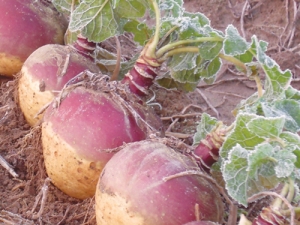Rewarding farmers who embrace sustainability
Winners of DairyNZ’s Sustainability and Stewardship awards in the Ballance Farm Environment Awards have their eyes firmly fixed on progressing a positive future for New Zealand dairy.
 Do not feed herbicide tolerant (HT) swedes to cows when the animals are in late pregnancy or early lactation, says DairyNZ.
Do not feed herbicide tolerant (HT) swedes to cows when the animals are in late pregnancy or early lactation, says DairyNZ.
Do not feed herbicide tolerant (HT) swedes to cows when the animals are in late pregnancy or early lactation.
That's the advice from DairyNZ following a lengthy investigation into the death of hundreds of dairy cows in Southland and Otago during winter/spring 2014.
Last week DairyNZ's swede working group (SWG) issued its final report; it cautions farmers against feeding HT swedes in late August/early September.
"This is when many of the known factors (warmer temperatures, new leaf growth, 'bolting'/stem elongation) that lead to ill-health and potential cow deaths can rapidly combine," the report says.
The report found that cow illness and deaths were the result of liver damage, possibly caused by higher levels of certain nitriles; these compounds can be formed as breakdown products following the consumption and digestion of glucosinolates (GSL) found in all brassica species.
There was also evidence of liver damage found in apparently healthy animals grazing swedes in early spring 2014. Information from the affected farms suggested that during this season many cattle had been fed on swede crops that had moved into the 'reproductive phase'.
The report says there is reliable evidence in scientific literature that this would result in exposure to higher concentrations of GSLs.
"A cross-sectional survey of swede crops in the Southland region aligned with this. In the calving and early lactation period a strong statistical association was found between feeding the HT swede cultivar and illness or death of animals.
"Analysis of GSLs in swedes found higher concentrations in upper leaves/stems and flowers in samples from HT plants."
DairyNZ has concluded that all cultivars of swedes have the potential to cause liver damage in cattle when a "multi-factorial situation exists". These factors include the physiological status of the animal, plant characteristics (i.e maturity/cultivar/physical composition), the effect of climate on plant characteristics and farm management practices.
It says the higher disease incidence reported during calving and early lactation was strongly associated with increased exposure to swede crops in their 'reproductive phase'.
"As HT swedes were shown to have higher concentrations of GSLs they exacerbated this risk.
"The air temperatures in the winter and spring of 2014 in Southland and South Otago were generally warmer than the 10 year average. In DairyNZ's opinion, these weather conditions contributed to swede crops retaining more leaf (which does not normally survive winter frosts) and the crops being in the 'reproductive phase' earlier than normal. "This therefore contributed to the clinical presentation of a known risk associated with feeding brassicas."
DairyNZ is reiterating the advice it gave farmers 15 months ago; aligned with managing the levels of GSLs consumed in the diet, particularly when swede plants begin the reproductive growth phase and GSL concentrations are expected to increase.
It also advised farmers not to feed swede crops in their reproductive growth phase.
"This is recognisable when the swede's stem elongates, new growth appears and the swede plant develops flowers and a seed head (referred to as 'bolting').
"In autumn, before the first frosts, be cautious when grazing animals on swede crops as they might eat more leaves than bulbs as the bulbs are hard and difficult to eat," it says.
At any time during the season, farmers are asked to be cautious when grazing animals on swede crops with a high leaf-to-bulb ratio, as cows may preferentially graze leaf.
Observe the physical characteristics of the crop being fed, monitor the health of cows and adjust their feed management if incidences of ill-health are observed.
Cow symptoms to watch for
◦ Weight-loss and ill-thrift
◦ Poor crop utilisation – leaving crop behind especially the bulb
◦ Cows not putting on condition despite adequate crop allocation
◦ Signs of photosensitivity
◦ One or two cow deaths.
A Southland farming leader wants the regional council to delay a proposed regional rates hike, much of which is intended to fund flood protection works.
Rural Women New Zealand (RWNZ) says access to personal banking services in rural communities is fundamental to promoting outcomes that benefit Kiwi consumers.
A group set up to boost education and promotion of wool says it has made positive strides during the first year of its three-year strategy.
Meat processor ANZCO Foods says despite a challenging business environment, it has posted a net profit before tax of $61 million for 2023.
The deer industry is working on getting more venison into Asia.
The red meat sector is welcoming the start of trade negotiations between New Zealand and the United Arab Emirates (UAE).